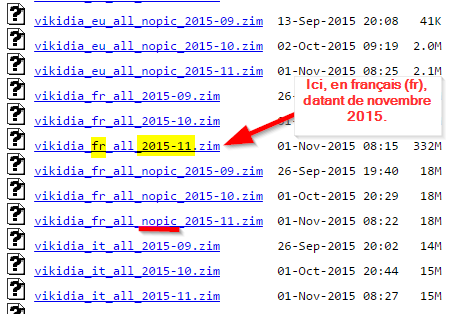

Few software applications other than VisiCalc are available for the computer according to a presentation at KansasFest 2012, fewer than 50 Apple III-specific software packages were ever published, most shipping when the III Plus was released. With a starting price between $4,340 to $7,800, the Apple III was more expensive than many of the CP/M-based business computers that were available at the time.
#KIWIX APPLE CODE#
Some of the features and code base of Apple SOS were later adopted into the Apple II's ProDOS and GS/OS operating systems, as well as Lisa 7/7 and Macintosh system software.
#KIWIX APPLE FULL#
Apple SOS allows the full capacity of a storage device to be used as a single volume, such as the Apple ProFile hard disk drive, and it supports a hierarchical file system. Its ability to address resources by name allows the Apple III to be more scalable than the Apple II's addressing by physical location such as PR#6, CATALOG, D1. The Apple III introduced an advanced operating system called Apple SOS, pronounced "apple sauce". These choices cannot be changed while programs were running, unlike the Apple IIc, which has a keyboard switch directly above the keyboard, allowing the user to switch on the fly.Īn advertisement for access to health information through the Apple III

The Apple III is the first Apple product to allow the user to choose both a screen font and a keyboard layout: either QWERTY or Dvorak. Unlike the Apple II, the Disk III controller is part of the logic board. Graphics modes include 560x192 in black and white, and 280x192 with 16 colors or shades of gray. Other Apple III built-in features include an 80-column, 24-line display with upper and lowercase characters, a numeric keypad, dual-speed (pressure-sensitive) cursor control keys, 6-bit (DAC) audio, and a built-in 140-kilobyte 5.25-inch floppy disk drive.
#KIWIX APPLE UPGRADE#
Third-party vendors produced memory upgrade kits that allow the Apple III to reach up to 512 kB of random-access memory (RAM). The Apple III is powered by a 1.8- megahertz Synertek 6502A or B 8-bit CPU and, like some of the later machines in the Apple II family, uses bank switching techniques to address memory beyond the 6502's traditional 64 kB limit, up to 256 kB in the III's case. Management believed that "once the Apple III was out, the Apple II would stop selling in six months", Wozniak said. Apple management intended to clearly establish market segmentation by designing the Apple III to appeal to the 90% business market, leaving the Apple II to home and education users. Though the Apple II contributed to the inspirations of several important business products, such as VisiCalc, Multiplan, and Apple Writer, the computer's hardware architecture, operating system, and developer environment are limited. The Apple III was designed to be a business computer and successor. Steve Wozniak and Steve Jobs expected hobbyists to purchase the Apple II, but because of VisiCalc and Disk II, small businesses purchased 90% of the computers. 3.1 Microsoft BASIC additional features.As a result, later Apple II models incorporated some hardware and software technologies of the Apple III, such as the thermal Apple Scribe printer. The Apple III's failure led Apple to reevaluate its plan to phase out the Apple II, prompting the eventual continuation of development of the older machine. Apple co-founder Steve Wozniak stated that the primary reason for the Apple III's failure was that the system was designed by Apple's marketing department, unlike Apple's previous engineering-driven projects. The Apple III Plus brought this up to approximately 120,000. Īn estimated 65,000–75,000 Apple III computers were sold. Development stopped and the Apple III was discontinued on April 24, 1984, and its last successor, the III Plus, was dropped from the Apple product line in September 1985. ĭamage to the computer's reputation had already been done and it failed to do well commercially. The Apple III was formally reintroduced on November 9, 1981. Serious stability issues required a design overhaul and a recall of the first 14,000 machines produced. The system was announced on and released in late November that year.

It had the internal code name of "Sara", named after Sander's daughter. Work on the Apple III started in late 1978 under the guidance of Dr. It was designed to provide key features business users wanted in a personal computer: a true typewriter-style upper/lowercase keyboard (the Apple II only supported uppercase) and an 80-column display. Running the Apple SOS operating system, it was intended as the successor to the Apple II series, but was largely considered a failure in the market. The Apple III (styled as apple ///) is a business-oriented personal computer produced by Apple Computer and released in 1980.


 0 kommentar(er)
0 kommentar(er)
